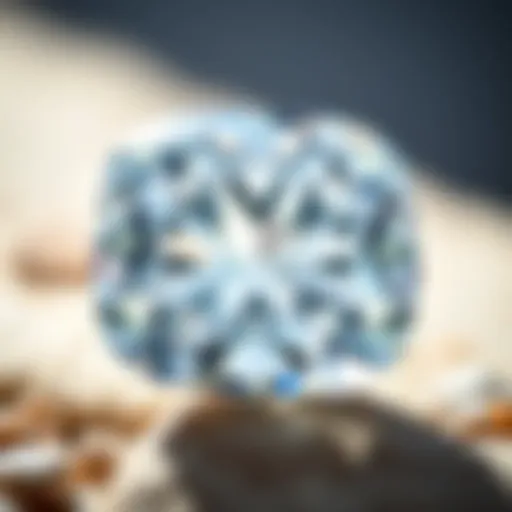Unlocking the Mysteries of Diamond Cuts: A Definitive Guide to Enhancing Brilliance
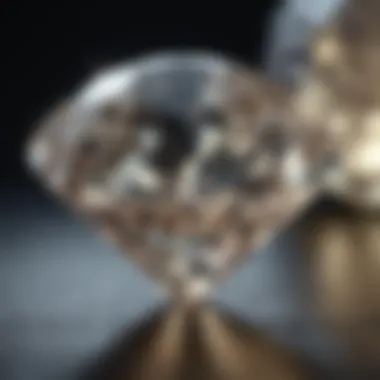

Overview of Gemstones and Minerals
The History of Gemstone and Mineral Use
Gemstones and minerals have captivated humanity for centuries, with a rich history deeply intertwined with culture and society. From ancient civilizations to modern times, these exquisite stones have held significant symbolism and value, transcending mere aesthetics to become symbols of power, prestige, and beauty.
Significance in Culture and Society
The significance of gemstones and minerals in culture and society is profound, with each stone often carrying deep cultural meanings and symbolism. They have been used in rituals, ceremonies, and as adornments, symbolizing wealth, status, and emotions. The cultural significance of these gems varies across different regions and eras, reflecting the diversity and richness of human heritage.
Gemstone Formation and Properties
The Formation Process of Gemstones
Gemstones are formed through a complex geological process that involves immense pressure, heat, and time. From the depths of the earth's crust to volcanic eruptions and other natural phenomena, gemstones undergo a transformative journey that imbues them with unique beauty and properties.
Properties that Define Gemstones
Gemstones are defined by a myriad of properties that set them apart from other minerals. These properties include color, clarity, cut, and carat weight, each playing a crucial role in determining a gemstone's value and allure. Understanding these properties is essential for gemstone enthusiasts and collectors seeking to appreciate the beauty and rarity of these precious stones.
Classification based on Color, Hardness, and Luster
Gemstones can be classified based on various criteria, including color, hardness, and luster. The color of a gemstone is a result of chemical impurities, while hardness is determined by the stone's resistance to scratching. Furthermore, luster refers to the way light interacts with the surface of the gemstone, defining its sparkle and brilliance.
Types of Gemstones
Precious vs. Semi-Precious Gemstones
Gemstones are broadly categorized into precious and semi-precious stones based on their rarity, value, and desirability. Precious gemstones, such as diamonds, rubies, sapphires, and emeralds, are revered for their exceptional beauty and scarcity. On the other hand, semi-precious gemstones, including amethyst, aquamarine, and citrine, though equally stunning, are more readily available.
Common Gemstone Varieties
Within the realm of gemstones, there exists a vast array of varieties, each with its own unique characteristics and allure. From vibrant red rubies to deep blue sapphires and mesmerizing opals, each gemstone variety offers a distinct beauty that caters to diverse preferences and styles.
Exotic and Rare Gemstones
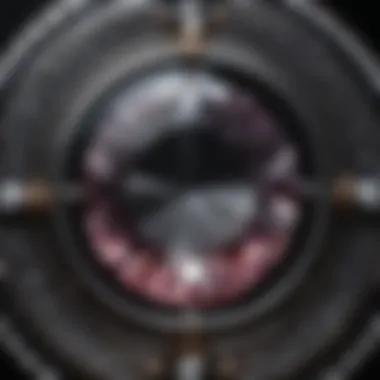

Among the myriad gemstones in the world, some stand out for their rarity and exotic appeal. These gemstones, such as alexandrite, taaffeite, and musgravite, are highly sought after by collectors and connoisseurs for their scarcity and incomparable beauty. Their uniqueness adds a touch of exclusivity to any jewelry or collection.
Identifying and Evaluating Gemstones
Factors Affecting Gemstone Value
Several factors influence the value of a gemstone, including its rarity, clarity, color intensity, and size. Gemstone evaluators consider these factors meticulously to assess the quality and worth of a stone, ensuring that each gem is valued accurately based on its unique attributes.
Techniques for Gemstone Identification
Gemstone identification requires a keen eye, specialized tools, and expertise in gemology. Professionals use a combination of visual inspection, gemological instruments, and scientific testing to accurately identify and differentiate between gemstone varieties. This meticulous approach ensures the authenticity and integrity of the gemstones being evaluated.
Assessing Gemstone Quality
Evaluating the quality of a gemstone involves examining its color, cut, clarity, and carat weight in detail. Gemologists scrutinize these aspects to determine the overall beauty, brilliance, and value of a gemstone, providing consumers and collectors with valuable insights into the worth and desirability of each stone.
Caring for Gemstones
Cleaning and Storing Gemstones Properly
Proper care and maintenance are essential for preserving the beauty and longevity of gemstones. Cleaning gemstones regularly with mild soap and lukewarm water, and storing them in a soft cloth or jewelry box helps prevent dust and dirt buildup, ensuring their luster and brilliance are maintained.
Avoiding Common Mistakes in Gemstone Care
Effective gemstone care involves avoiding common mistakes, such as exposing gemstones to harsh chemicals, extreme temperatures, or physical impact. By following proper care guidelines and handling gemstones with care, enthusiasts can protect their treasured stones from damage and ensure they remain radiant for years to come.
Preservation Tips for Specific Gem Types
Different gemstones require specific care regimens to preserve their beauty and integrity. For example, opals should be kept away from direct sunlight to prevent color fading, while pearls benefit from regular wear to maintain their luster. Understanding the unique needs of each gemstone type is vital for ensuring their longevity and beauty are preserved.
Introduction to Diamond Cuts
In the realm of gemstones, understanding the intricacies of diamond cuts stands as a crucial facet. The precision with which a diamond is cut not only enhances its brilliance and sparkle but also influences its overall value. As we embark on this comprehensive guide to diamond cuts, we unravel the significance of this fundamental aspect in the world of gemology. By delving into the various types, characteristics, and historical evolution of diamond cuts, we aim to shed light on how each cut plays a pivotal role in shaping a diamond's aesthetics and worth.
Importance of Diamond Cuts
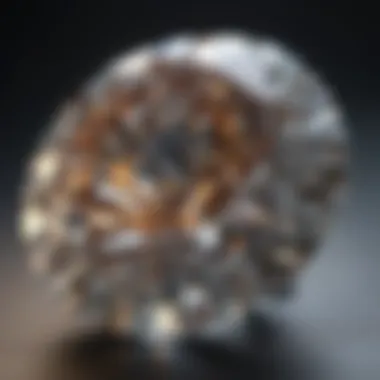

Diamond cuts hold a paramount position in the realm of gemstone appreciation, with their ability to significantly impact a diamond's visual allure and market value. One of the key aspects of diamond cuts lies in their unparalleled capacity to enhance a diamond's brilliance and sparkle with utmost precision. This is achieved through the intricate arrangement of facets that reflect light in a mesmerizing dance, captivating the beholder's gaze and exuding a mesmerizing radiance. Diamond cuts also wield a profound influence on the value of a diamond. The artistry and craftsmanship involved in cutting a diamond can markedly elevate its worth, making it a sought-after gem in the world of jewelry. A well-cut diamond not only exhibits exceptional brilliance but also fetches a higher price in the market due to its superior craftsmanship and visual appeal, underlining the critical role that cuts play in determining a diamond's desirability and investment value.
Historical Evolution of Diamond Cuts
The evolution of diamond cuts traces a fascinating journey through time, reflecting the evolution of human ingenuity and technological advancements in the field of gemology. From the simplicity of Rose Cuts to the complexity of Modern Brilliant Cuts, each era has witnessed remarkable innovations in cutting techniques that have shaped the way we perceive and appreciate diamonds. From Rose Cuts to Modern Brilliant Cuts: The transition from Rose Cuts, characterized by a flat base and a domed top with a faceted crown, to Modern Brilliant Cuts marks a significant leap in diamond cutting precision. The advent of innovative cutting techniques paved the way for the creation of intricate facets that maximize light reflection, resulting in unparalleled brilliance and scintillation in diamonds. Influence of Technology on Cutting Techniques: The evolution of diamond cuts has been profoundly influenced by technological advancements, with modern tools and equipment revolutionizing the way diamonds are shaped and faceted. The integration of computer-aided design (CAD) and precision cutting tools has enabled gemologists to achieve unrivaled levels of symmetry and precision in diamond cuts, pushing the boundaries of creativity and aesthetic perfection.
Popular Types of Diamond Cuts
In delving into the realm of diamond cuts, it becomes evident that understanding the popular types of cuts is quintessential to appreciating the artistry involved. Each cut, whether classic or avant-garde, plays a pivotal role in enhancing the brilliance and allure of diamonds. From the timeless Round Brilliant Cut to the elegant Princess Cut and the sophisticated Emerald Cut, each type brings forth unique characteristics that contribute to the overall beauty and value of the diamond. Exploring these popular types not only unveils the craftsmanship of diamond cutting but also provides insight into the intricate choices available to connoisseurs and collectors.
Round Brilliant Cut
Facets and Symmetry
When delving into the specifics of the Round Brilliant Cut, one cannot overlook the significance of facets and symmetry. The meticulous arrangement of facets on a round diamond not only maximizes light reflection but also accentuates the diamond's fire and brilliance. The symmetrical alignment of these facets ensures a uniform and mesmerizing display of light, making the Round Brilliant Cut a popular choice for those seeking unparalleled sparkle and scintillation. Despite its ubiquity, achieving perfect symmetry and ideal facet proportions requires exceptional skill and precision, making each Round Brilliant Cut diamond a work of art in its own right.
Fire and Scintillation
Turning our attention to the Fire and Scintillation of the Round Brilliant Cut, we witness the enchanting play of light within the diamond. Fire refers to the colorful flashes of light that occur when light enters and exits the diamond, while scintillation pertains to the sparkling effect produced by the diamond's facets. These dynamic features of the Round Brilliant Cut not only mesmerize onlookers but also reflect the diamond's quality and craftsmanship. However, achieving the perfect balance of fire and scintillation requires a delicate interplay of cut proportions and facet precision, underscoring the artistry involved in creating a truly magnificent Round Brilliant Cut diamond.
Princess Cut
Square Shape and Facet Arrangement
Exploring the Princess Cut unveils its distinctive square shape and unique facet arrangement. Unlike traditional round cuts, the Princess Cut exudes modern elegance with its sharp corners and multifaceted structure. The square shape not only sets it apart aesthetically but also influences the diamond's brilliance by creating a pattern of light reflections that enhance its overall allure. The careful arrangement of facets on a Princess Cut diamond contributes to its striking appearance, making it a popular choice for those seeking a contemporary and sophisticated look in their jewelry.
Modern Elegance
Bolstering the allure of the Princess Cut is its modern elegance, appealing to individuals with a taste for sleek and refined designs. The clean lines and precise angles of the Princess Cut embody a sense of sophistication, making it a favorite among those embracing contemporary jewelry trends. Its geometric charm and versatility in various setting styles further enhance its appeal, catering to individuals who value both aesthetic appeal and structural integrity in their diamond choices.
And so on for the remaining diamond cuts.
Factors Influencing Diamond Cuts
Factors influencing diamond cuts play a vital role in shaping the appearance and value of these precious gemstones. The intricate art of diamond cutting intertwines with various factors that significantly impact the final outcome. Understanding the importance of factors influencing diamond cuts is paramount for gemstone enthusiasts, collectors, and jewelry designers seeking to appreciate the nuances of these masterfully crafted gems.
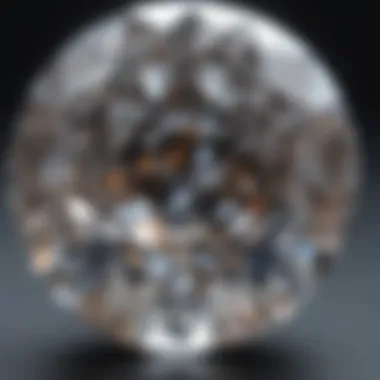

Proportions and Angles
Ideal Cut Specifications
Ideal cut specifications are fundamental to the overall brilliance and appeal of a diamond. The precise proportions and angles of a diamond directly affect how light interacts with the stone, ultimately determining its sparkle and fire. Ideal cut specifications emphasize symmetry and alignment, enhancing the diamond's beauty and maximizing its light performance. This meticulous attention to detail in ideal cut specifications underscores its popularity among gemstone connoisseurs and its beneficial contribution to showcasing a diamond's inherent radiance.
Impact on Light Performance
The impact of light performance on diamond cuts is a crucial consideration when evaluating the gem's beauty. Light performance refers to how light reflects and refracts within the diamond, creating mesmerizing patterns of brilliance and scintillation. The precise proportions and angles optimized for light performance contribute to the diamond's optical performance, ensuring maximum light return and exceptional sparkle. Understanding the intricate relationship between proportions, angles, and light performance is essential for discerning individuals looking to invest in a dazzling diamond.
Symmetry and Polish
Aesthetics and Reflections
Symmetry and polish are key elements in enhancing a diamond's aesthetics and reflections. A well-crafted diamond with symmetrical facets and flawless polish captures and reflects light beautifully, resulting in a stunning visual display. The meticulous attention to symmetry ensures that each facet plays its part in refracting light, while high-quality polish enhances the diamond's luster and brilliance. Emphasizing symmetry and polish underscores the commitment to producing exceptional diamonds that exude elegance and radiance.
Quality Standards
Quality standards serve as benchmarks for assessing the craftsmanship and value of a diamond. Adhering to strict quality standards guarantees that a diamond meets specified criteria for cut precision, symmetry, and polish. By upholding quality standards, diamond cutters produce gemstones of superior quality, reflecting mastery in the art of diamond cutting. The emphasis on quality standards not only elevates the aesthetic appeal of diamonds but also ensures consistency and excellence in the gemstone industry.
Fancy Colored Diamonds
Unique Cutting Considerations
Fancy colored diamonds present unique cutting considerations that distinguish them from traditional colorless diamonds. The cutting process for fancy colored diamonds requires careful deliberation to enhance the intensity and distribution of color within the stone. Incorporating specific cutting techniques to maximize color saturation while maintaining brilliance is essential in showcasing the rare beauty of fancy colored diamonds. Understanding the nuances of unique cutting considerations in colored diamonds is essential for enthusiasts seeking to explore the vibrant world of natural colored gemstones.
Intensity and Saturation
The intensity and saturation of color play a pivotal role in defining the allure of fancy colored diamonds. Intensity refers to the strength of the color, while saturation measures the purity and vibrancy of the hue. Balancing intensity and saturation through precise cutting techniques ensures that fancy colored diamonds exhibit rich and consistent coloration. By mastering the interplay between intensity and saturation, diamond cutters can elevate the visual impact of colored diamonds, creating mesmerizing gemstones that captivate admirers with their vivid hues and unparalleled beauty.
Conclusion
In the realm of diamonds, the conclusion serves as the pinnacle of our exploration into the world of diamond cuts. Understanding the significance and impact of a diamond cut is paramount in appreciating the beauty and value of these exquisite gemstones. This final section encapsulates the essence of our discourse, emphasizing the pivotal role that diamond cuts play in shaping a diamond’s character and allure. From symbolizing personal preferences to practical investment considerations, the conclusion serves as a holistic reflection on the multifaceted nature of diamond cuts.
Appreciating Diamond Cuts
Symbolism and Personal Preferences
Symbolism and personal preferences are integral facets of diamond cuts, adding layers of meaning and individuality to each gem. In the domain of luxury and aesthetics, symbolism ties emotions and memories to the physicality of a diamond, making it more than just a stone but a representation of personal values and stories. Understanding the symbolism behind a particular cut allows individuals to express their uniqueness and sophistication through their choice of jewelry. Personal preferences in diamond cuts reflect one's style, taste, and identity, influencing not only the visual appeal but also the emotional connection one has with the jewelry. The symbolism and personal preferences embedded in diamond cuts elevate the significance and desirability of these exquisite gemstones.
Investment Value
Investment value in the context of diamond cuts is a crucial aspect to consider for collectors and enthusiasts alike. The inherent characteristics of a diamond cut such as brilliance, fire, and rarity directly impact its investment value. Diamonds with exceptional cuts not only exhibit a mesmerizing beauty but also have a higher potential for appreciation over time, making them lucrative investment options. Understanding the market trends, quality standards, and rarity of certain diamond cuts is essential for making informed investment decisions. The investment value of diamond cuts lies not only in their monetary worth but also in the historical, cultural, and aesthetic value they hold. It is through this intersection of financial prudence and intrinsic beauty that diamond cuts acquire a dual significance in the world of gemstones.





